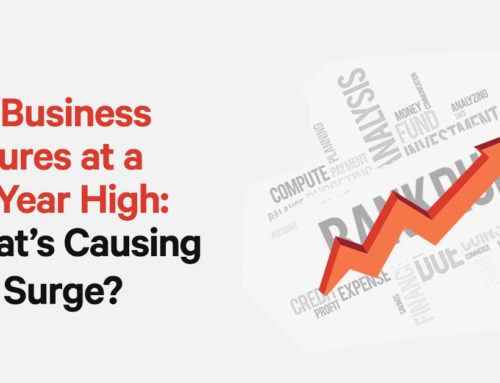The latest figures released by the Office for National Statistics, revealing that UK insolvencies have skyrocketed to a 30-year high, have sent shockwaves through the business community. This surge serves as a stark reminder of the challenging trading environment businesses currently face. With every category of insolvency on the rise, it’s crucial to delve deeper into the underlying factors driving this unprecedented trend and understand the implications for businesses across the UK.
The increase in insolvencies isn’t merely statistical; it mirrors the profound economic challenges businesses grapple with. From escalating costs to disrupted supply chains, businesses face enormous pressures. The lingering effects of the COVID-19 pandemic add to existing vulnerabilities and raise new obstacles for businesses to overcome.
Unprecedented Magnitude: Understanding the Surge
In 2023, the sheer reality of economic strain manifested in the form of over 25,000 company insolvencies, a figure marking the highest level witnessed since 1993. Voluntary liquidations, in particular, have risen to a historic high since record-keeping began in 1960. This increase serves as a big indicator of the extreme challenges confronting businesses across the nation.
Behind each statistic lies a narrative of struggle and adversity as businesses wrestle with the weight of mounting debts, diminishing revenues, and an uncertain future. From small family-owned enterprises to sprawling multinational corporations, no segment of the business landscape has been spared from the relentless onslaught of economic headwinds battering the economy. The repercussions of these insolvencies extend far beyond the boardrooms, touching the lives of employees, suppliers, and entire communities.
When businesses face insolvency, the effects on people’s lives are massive. Jobs are at risk, families are unsure about their future, and the places where these businesses are located feel the impact too. The problems caused by insolvency spread out and touch everyone, highlighting the importance of helping struggling businesses and minimising the overall impact on society.
Factors Fuelling Insolvency: Understanding the Perfect Storm
A combination of factors contributes to this perfect storm of financial strain. Soaring costs, from energy bills to interest rates, add immense pressure on businesses struggling with weakened consumer confidence and inflation. Coupled with ongoing global uncertainties, many businesses find themselves with diminishing value, prompting the realisation that the game may be up for numerous enterprises.
These challenges are multifaceted and intricate. Supply chain disruptions, the lack of labour, and regulatory shifts further add to the existing difficulties, creating a daunting operating environment. Navigating these uncertainties requires resilience, adaptability, and strategic awareness. Businesses must reassess their operational models, identify inefficiencies, and explore alternative revenue streams to weather the storm.
Spreading Stress: Impact Across Business Spectrum
Initially, smaller businesses and those opting for creditors’ voluntary liquidations (CVLs) bore the brunt of rising insolvencies. However, stress has now spread to mid-market and larger companies. Challenges like refinancing hurdles and inflationary pressures make the situation worse, complicating the prospects of a successful recovery. The consequences go beyond individual businesses, casting ripple effects throughout the broader economy.
The increasing prevalence of insolvencies among mid-market and larger companies is particularly concerning. These entities, pivotal for economic growth and employment, face mounting financial pressures. The risk of job losses, reduced investment, and economic stagnation looms large. Urgent action is essential to support these businesses and safeguard the wider economy.
Navigating Forward: Challenges and Opportunities
As the trajectory of insolvencies continues, businesses find themselves navigating an ever-evolving landscape filled with unprecedented challenges. In this dynamic environment, businesses need to identify avenues for resilience and renewal. Strategic restructuring, asset realignment, and debt renegotiation are vital in weathering the storm and emerging stronger. Proactive measures are key, and seeking expert guidance can facilitate navigating the intricacies of insolvency proceedings.
While the road to recovery may be difficult, it’s by no means impossible. By embracing a culture of innovation, businesses can harness creativity and innovation to identify new opportunities, diversify revenue streams, and differentiate themselves in a competitive marketplace. What’s more, adopting agile business practices allows businesses to adapt swiftly to changing market dynamics, capitalise on emerging trends, and position themselves at the forefront of industry evolution.
Plus, collaboration between businesses, government agencies, and financial institutions is essential in facilitating recovery efforts. Through coordinated efforts and shared resources, stakeholders can work together to provide businesses with the support and help needed to navigate through turbulent times. Whether through access to capital, regulatory relief, or targeted assistance programs, collaborative initiatives can drive recovery efforts and accelerate the path towards economic growth.
Future Uncertainties: Preparing for Challenges Ahead
As we approach the second quarter of 2024, the concern surrounding businesses having to endure external conditions continues to linger, casting a shadow of uncertainty over the economic landscape. The potential for prolonged challenges poses a significant threat, potentially preventing any anticipated decrease in insolvencies. Industries such as retail, hospitality, and construction are particularly susceptible, facing heightened vulnerability amidst the looming increase in the national living wage and unpredictable fluctuations in interest rates.
In response to these challenges, businesses must maintain a strong commitment to vigilance, adaptability, and readiness to navigate further economic turbulence. Proactive measures, including careful financial planning, strategic diversification, and agile operational strategies, are vital to reduce risks and seize growth opportunities.
Yet, amid the daunting obstacles that lie ahead, there’s a spirit of optimism within the UK business community. The resilience and innovation that have characterised British entrepreneurship throughout history continue to shine through, serving as beacons of hope in times of adversity. By embracing change, fostering a culture of innovation, and prioritising collaboration and solidarity, businesses can not only weather the storm but emerge stronger and more resilient than ever before.
As we forge ahead into uncharted territory, let us draw inspiration from the determined spirit of British enterprise. Together, we can navigate the challenges of today and build a brighter, more prosperous future for all.
Empowering Businesses: Take Control of Your Financial Future
At Leading Insolvency Practice, we understand the challenges businesses face amid the current economic climate. Our team of experts is committed to providing tailored solutions to meet your unique needs. Whether facing liquidation, administration, or restructuring, we’re here to guide you. Take charge of your financial future today. Call us on 0800 246 1845 or email us at mail@leading.uk.com to schedule your consultation and discover how we can help navigate the path to recovery.






